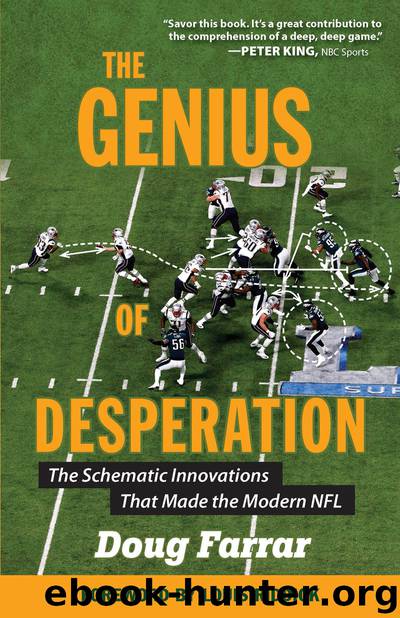The Genius of Desperation by Doug Farrar

Author:Doug Farrar
Language: eng
Format: epub
Publisher: Triumph Books
Published: 2018-08-02T00:00:00+00:00
6. Hogs and Geniuses: The NFL in the 1980s
“Greed, for lack of a better word, is good. Greed is right. Greed works. Greed clarifies, cuts through, and captures the essence of the evolutionary spirit. Greed—in all of its forms—greed for life, for money, for love, knowledge, has marked the upward surge of mankind.”
—Michael Douglas as Gordon Gekko in Wall Street
The 1980s were a decade of excess in many ways, and the NFL followed suit with the flashiest, most complex versions of the pro game anyone had ever seen. Many innovators defined the era, but one stood above all the rest, and he came as close to the perfect version of offensive football as could be imagined. The rest of the league would be forced to respond to the trail that Bill Walsh had finally been allowed to blaze.
Bill Walsh: The Genius
Bill Walsh was informed to a great extent by perhaps the NFL’s two greatest offensive geniuses before him and he took the things he learned from Sid Gillman and Paul Brown to a new level, building what eventually became known as the West Coast Offense while putting his stamp on the game forever.
Walsh started his professional coaching career as the Oakland Raiders’ running backs coach in 1966, and Raiders main man Al Davis was a Gillman acolyte. Davis worked under Gillman as an assistant with the San Diego Chargers from 1960 through 1962. It was under Davis’ auspices that Walsh started to see his own versions of the brilliance of Gillman’s geometry. The timing of the passing plays and the mathematical precision of passing concepts came to Walsh’s mind from Gillman’s work in the American Football League. Gillman was fond of saying that a football field is 53 ⅓ yards wide and 100 yards long and he was going to force defenses to cover the entire width and length of it.
Gillman did so with innovative vertical concepts, but he also did so with geometry. In the early 1960s, Gillman spoke with assistant Tom Bass about the triangular nature of the ideal combination of the quarterback’s passing and the receiver’s route running. If the angles were correct, Gillman hypothesized that the quarterback and receiver could be timed up before the snap of the ball even happened.
Bass met with a mathematics professor from San Diego State in 1964, and the two men deduced that the perfect combination of quarterback, receiver, and route was indeed triangular in nature. In its basic form, the triangle consisted of: the route the receiver ran until he cut to a different angle, the remainder of the route run after the break, and the movement of the ball from quarterback to receiver. No matter the route, Gillman saw consistency in the geometry. “It was a fully dimensional approach, utilizing the backs and tight ends more extensively than other offenses,” Walsh said years later in The Genius. “A typical NFL team might have three or four pass patterns for the halfback, but the Raiders’ system had as many as 20, and even they didn’t use anything close to Gillman’s whole playbook.
Download
This site does not store any files on its server. We only index and link to content provided by other sites. Please contact the content providers to delete copyright contents if any and email us, we'll remove relevant links or contents immediately.
Relentless: A Memoir by Julian Edelman(1593)
ALEX FERGUSON My Autobiography by Alex Ferguson(1219)
1942 by Winston Groom(1192)
Football's Strangest Matches by Andrew Ward(1192)
Cristiano Ronaldo: The Biography by Guillem Balague(1134)
The Source by James A. Michener(1128)
When Pride Still Mattered by Maraniss David(1056)
Time's Champion by Time's Champion (Craig Hinton & Chris McKeon)(1026)
Chiefs by Stuart Woods(1016)
Gunslinger by Jeff Pearlman(963)
0.721 by Gary Webster(955)
Where Men Win Glory: The Odyssey of Pat Tillman by Jon Krakauer(953)
Snake by Mike Freeman(898)
Coming Back Stronger by Drew Brees & Drew Brees(881)
Paterno by Joe Posnanski(851)
League of Denial by Mark Fainaru-Wada(845)
Deal Breaker by Harlan Coben(814)
The Cost of These Dreams by Wright Thompson(783)
It Takes What It Takes by Trevor Moawad(772)
